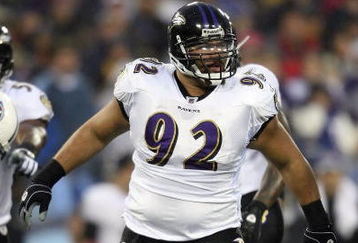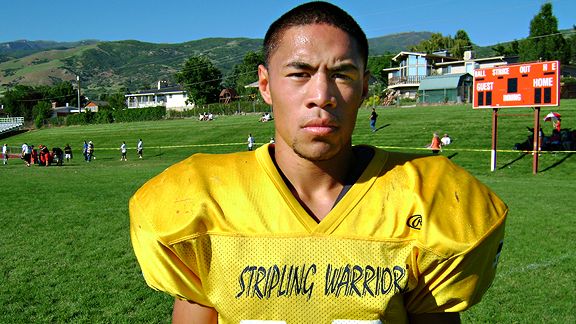
In early
1984,
Dick Tomey lured an 18-year-old lineman from C
ampbell High School into the memorabilia room of his house.
Amosa Amosa, attending a recruiting barbecue held by the
University of Hawaii's coach at the time, looked in awe at the gleaming trophies, signed footballs and yellowed newspaper clippings.
When Tomey plucked a jersey from a shelf and held it up -- Jesse Sapolu's old No. 76 -- the kid from Campbell was sold.
"You come here, this is your number," Amosa was told by Tomey, who clearly did his homework more than 25 years ago.
See, you leave Western Samoa at age 12 and your athletic hero isn't Joe Montana or Walter Payton. It's someone who looked like you, a future Pro Bowler of Samoan ancestry, who would block for Montana and Steve Young and win Super Bowls for Bill Walsh's 49ers.
"Jesse Sapolu was my idol, I was almost shaking," Amosa recalled. "I called home that night and said, 'Dad, I think I'm going Hawaii already.' "
Condolences were quickly sent to BYU, Utah, Washington and Portland State, which, now it can be told, was never in the running.
"As a senior at Campbell, I didn't even know where Portland was," Amosa said. "I was like, 'Portland, is that a state?' "
We laughed over the phone, catching up for the first time in more than two decades. Once my teammate on an inglorious Campbell football team in 1982, Amosa, two years behind me, would succeed me as the Sabers' starting center on the basketball court and become the school's most accomplished student-athlete of his era.
While I crisscrossed the mainland to finish school and start a journalism career, Amosa stayed home -- becoming one of the 100 greatest players in the annals of UH football, an accolade that has genuinely humbled him.
"All those great players, I just didn't know if they would put me on that incredible list," he said. "I am so honored, I can't even tell you."
His football accomplishments -- first-team All-Western Athletic Conference, named twice to the prestigious Warrior Club and to the 1988 Hula Bowl, member of the first all-Polynesian line in NCAA history -- cemented his credentials for UH's top 100. If he wasn't snapping the football and then nimbly using his 6-foot-2, 285-pound frame to pull his blocks in a triple-option offense -- if he didn't play on a UH team that knocked off No. 9 Iowa his senior season and was probably the best 9-3 squad never to go to a bowl game -- Amosa doesn't join honorees ranging from Larry Price to Colt Brennan, from Tommy Kaulukukui to Jason Elam.
But the numbers and victories do little to paint the portrait of Amosa, who fittingly came home last year as head football coach at Campbell, back to where a bamboo-shoot thin freshman could barely bench-press the 45-pound bar that held the weights.
Remember the old TV series starring Gabe Kaplan and John Travolta, where the former student returns to teach all the knuckleheads at his dilapidated Brooklyn public school? Amosa coming back to work with kids in Ewa Beach was essentially "Welcome Back, Kotter" -- Hawaiian-style.
Quick story: A Campbell teacher approached me after a Hawaii Pacific College-Chaminade game in 1983 (I rode the bench for a year at HPC), and he kept gushing over how Amosa had affected the student body in ways I never could.
"It's one thing when you used to walk across campus with your books under your arms," he said. "But they still see you as haole. With Amosa, it's different. The kids, they relate to him. They watch and follow. Some have even stopped holding up D-building with their feet. Now they go to class."
The words partially stung then, but I know now what he meant -- how a hulking Samoan kid, who deigned to carry his bulky algebra books under his arm and held his head high and proud like the honor student he became, well, a young man like that could effect real change at Campbell.
Then and now.
In the hour or so we spoke this past week, Amosa never mentioned the Sabers going 11-3 last year in his inaugural season as head coach. Instead, he talked about the pride he felt when parents came up to him after a preseason game and said they got chills -- "like chicken skin," Amosa said -- when they heard their kids singing the alma mater. That it occurred a year after the band didn't show up at Farrington and none of the kids knew the words brought chills to Amosa.
When he boasted about the kids he coached at Campbell and Aiea, where he was the offensive coordinator for nine years, Amosa didn't talk about the MVPs; he talked about the ones who overcame adversity -- physical disabilities, attitude, the ones who resisted peer pressure to hold up D-building and rub their belly after double lunch.
"Da buggah get one heart as big as anybody," he said about Lalo Respicio, his Campbell quarterback this season. "Talk about great character. 3.6 GPA. Humble. Works hard. So coachable. Always picking up people.
"The wins are nice. But to have good character, to have pride in your community, that's the vision and philosophy."
Good Amosa trivia: As a Campbell assistant, Amosa Amosa once coached Kaleopa Kaleopa. (The oldest boy in a Samoan family often is bestowed a double name). His roommate at UH: volleyball star Allen Allen.
He once showed up in a muddy downpour at Leilehua in bare feet, ready to assist then-Campbell coach Darren Hernandez.
"You had to see him. His pants were rolled up and he said his shoes were soaked," said Hernandez, now the patriarch of Kapolei's program and our friend and teammate on the legendary 0-7-1 Sabers of '82. "I finally told him, 'Amosa, you can't coach in bare feet. Put your shoes on.'"
Hernandez added, "So unassuming, so humble, you would never know Amosa accomplished what he did as an athlete or a coach."
Most revealing Amosa story: A certain OIA school, hard off Nimitz, was about to hire him as its next head coach several seasons ago when a concern arose at the last minute -- it was suggested the braided ponytail that ended in the middle of his back might have to be lopped off for the sake of school image.
Amosa politely told the principal that his long, flowing black hair was important to him, because it represented the bond between him and his wife of almost 15 years now, Akenese, who would braid it every morning.
"Because so much time was spent on coaching, I see it as a time to tell her I love her every morning, thank her for our six children, a chance to say our goodbyes for the day," Amosa said.
When the word "image" kept coming up, Amosa finally said, "I feel the character of a person is way more important than image," and he happily went back to Aiea, without the job.
Little regret remains over the experience, just as little regret remains over going undrafted, not even afforded an NFL tryout after his standout senior season. (Amosa figured playing in Paul Johnson's triple-option scheme soured scouts on his ability to pass protect, that 285 pounds was thought to be too small for a center.)
No, if Amosa went pro or got another head-coaching job, who would come back to Ewa Beach and influence kids the way he used to as a student 25 years ago? How could the man his Samoan brethren call "Fata" -- the high-talking chief of the family among his 10 siblings -- return to make a difference?
To motivate us during our Campbell basketball careers, the late Bob Nakagawa -- the Bobby Knight of the OIA West -- used to call Amosa and me, "Big for nothing." Talk about irony.
Wherever Coach Nakagawa is today, he knows: Amosa was big for something.
His family. The teammates and classmates he touched at Campbell and UH. And the multitude of kids who learned there was no shame in carrying your books across the grass on your way to class.
Full Article
 Olin Kreutz's name has come up a few times in recent months, and typically always in the same context: team leader, enforcer, tough guy. Kreutz has been the anchor of the Chicago Bears line for more than a decade, and his presence always precedes him.
Olin Kreutz's name has come up a few times in recent months, and typically always in the same context: team leader, enforcer, tough guy. Kreutz has been the anchor of the Chicago Bears line for more than a decade, and his presence always precedes him. 














